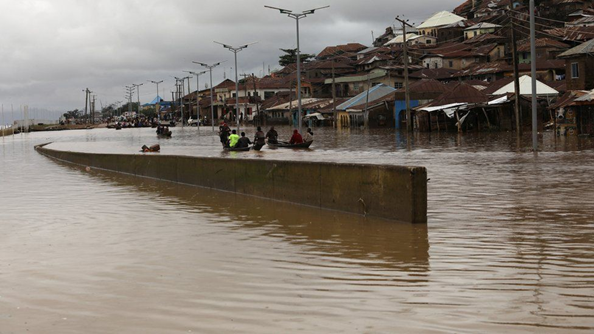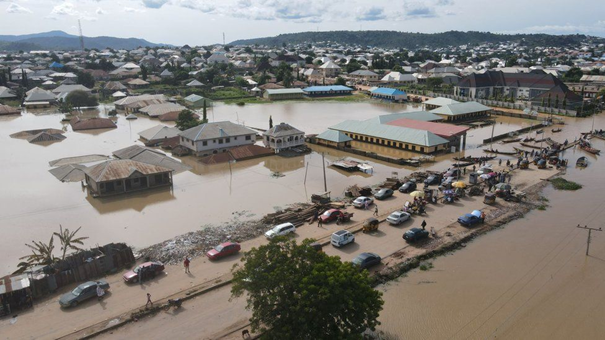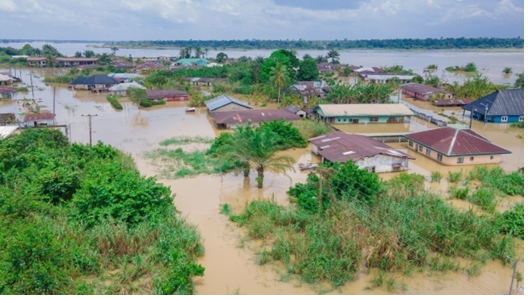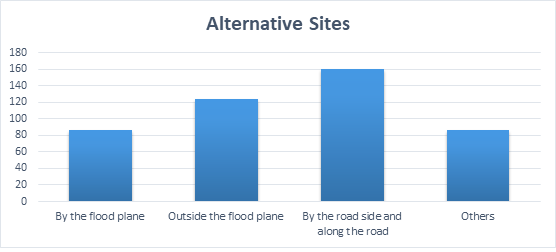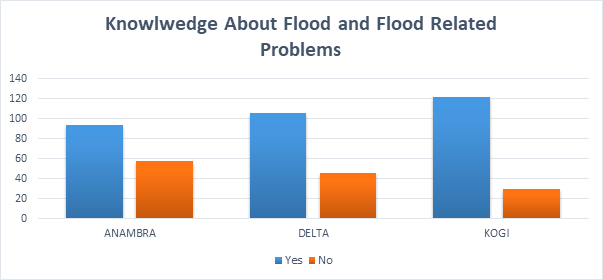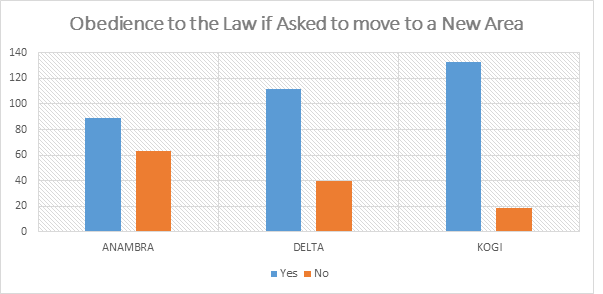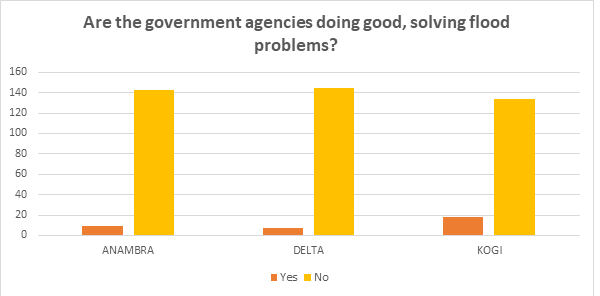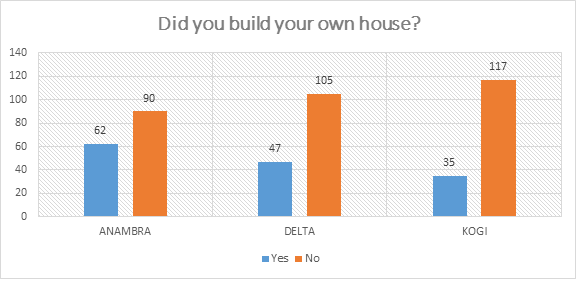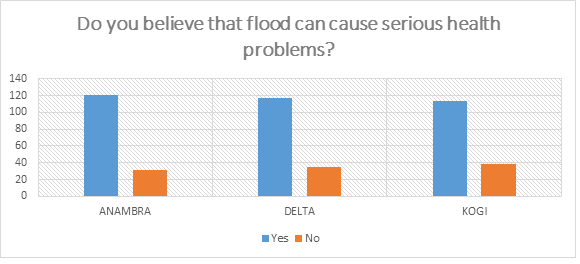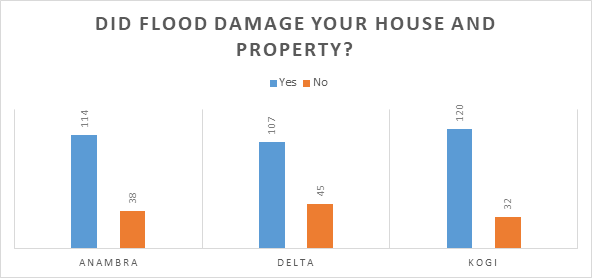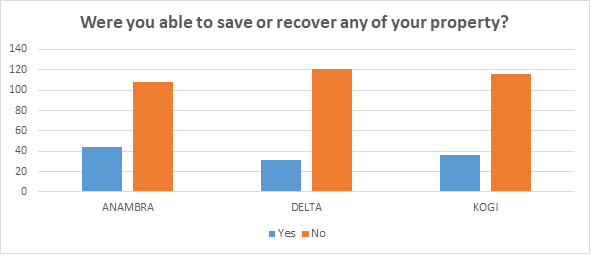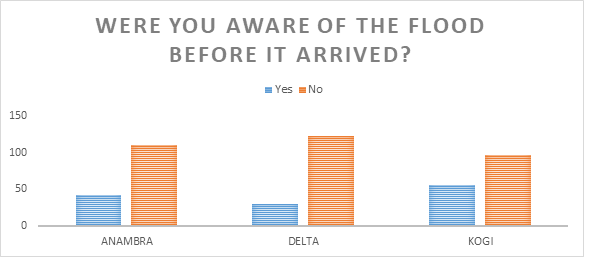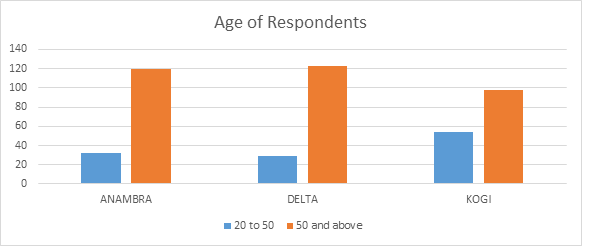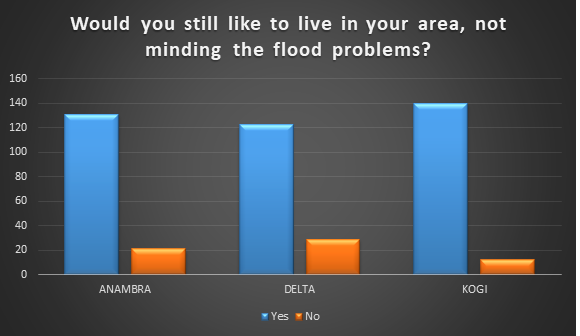Corrupt Government Practices, Regulatory Oversignt, Igorance and Negligence, the Key Factors Affecting Sustainable Urban and Rural Devlopments in Nigeria: Heance, Floodings
- Obiadi B. N
- Onuorah I. M.
- Mbah P. U.
- Okafor C. C.
- Kikanme E. I.
- 39-60
- Sep 29, 2023
- Architecture
Corrupt Government Practices, Regulatory Oversignt, Igorance and Negligence, the Key Factors Affecting Sustainable Urban and Rural Devlopments in Nigeria: Heance, Floodings
Obiadi B. N, Onuorah I. M., Mbah P. U., Okafor C. C., Kikanme E. I.
Department of Architecture, Faculty of Environmental Sciences, Nnamdi Azikiwe University, Awka, Anambra State, Nigeria
DOI: https://doi.org/10.51244/IJRSI.2023.10907
Received: 21 August 2023; Accepted: 29 August 2023; Published: 29 September 2023
ABSTRACT
Human experiences of the urban spaces have been reshaped by events and how the public domain is framed have produced nagging quests for solutions. These are added to the hitherto baffling situations of how the sustainability of urban and rural spaces have often been affected and on many occasions preculded by the decaying urban fabrics, unplanned physical developments and poor space administration. The 2022 flooding in Nigeria, that partly resulted from corrupt government practices and regulatory oversight have destroyed more lives and properties in the country yet, not enough efforts have been put in place to curb the natural catastrophe. The encrochment and destruction of the natural environment without proper and adequate mitigation practices and infrastructural reinforcement of the areas attributed to the problems however, the major factor could be the neighbouring Cameroon’s Lagdo Dam, opened to ease the water pressure on its side of the border along the Benue River without persuasive measures in Nigeria to serve as a buffer. Nigeria still has not completed the Dasin Hausa dam, started decades ago that would have been two-and-a-half times the capacity of the Lagdo dam in Cameroon, and would generate 300MW of electricity and irrigate about 150,000 hectares of farmland across three states and that needs to be rectified.
Key words: flooding, development, housing, architecture, government, development laws
INTRODUCTION
Some scholars have suggested that the basis of urban life in Africa is so very recent in an historical sense, that we are still able to detect some of the early characteristics in many of the towns of contemporary Africa (Okonkwo, 1998 citing Gutkind, 1974). Both subsistence economy and nomadism still prevail over most of the continent today. Whether or not the prevalence of these early characteristics is widespread is a matter of less important in this work. Rather, of interest, is the presentation of an insight into the socioeconomic and sometimes political phenomena of continent’s failed urban and rural development practices.
As man’s attitude, towards the group, the community and society of which he is a member, has been changing throughout known history, so his reaction to his environment has passed through successive stages of transformation. Cities have played an important role in this process, which consists of a never-ending dialogue between challenge and response and which derives to strength and continuity from elementary thoughts of mankind-religion, exchange of ideas and goods and need for protection and gregarious living. For millennia, human efforts have been directed, as far as cities are concerned, towards the same goal. Always and everywhere, the basic elements of cities have been the same-dwelling houses, public buildings, and spaces between them. But the form and its meaning have changed, for both express the spiritual and intellectual conception of the universe that men have made for themselves (Okonkwo, 1998 citing Gutkind, 1974:11 – 12).
Today, the major threat to human environment is more complex, more closely connected with the very way in which cities are built. For example, the largest cities have grown nearly tenfold in a century. Yet, there consumption of land is greater still. An immense transport system is required. In the wealthier countries this bears strongly on the fact that masses of automobiles raise the level of air pollution and noise, and create serious problems of congestions and accidents. In poor countries where poor housing structures dominate the urban landscape, spaces are littered with settlements lacking the most basic urban infrastructures. All this tend to reduce the quality of the human environment especially, in the urban areas (Okonkwo, 1998: 32).
The problems and challenges posed by the rapid urban growth in Nigeria are immense. More easily observable and perhaps very frightening are the general human and environmental poverty, the declining quality of life and the underutilized as well as the untapped wealth of human resources. Housing and associated facilities (such as water, electricity, waste disposal) are grossly inadequate. Millions live in substandard environments called slums, plagued by squalor and grossly inadequate social amenities, such as, a shortage of schools, poor health facilities and lack of opportunities for recreation among others. Juvenile delinquency and crime have become endemic in urban areas as a result of the gradual decline of traditional social values and the breakdown of family cohesiveness and community (Adepoju and Adetoye, 1995). All these are urbanization problems.
Urbanization is not a recent phenomenon in the history of Nigeria. Also, city growths date back into the country’s pre-colonial era. Both urbanization and city growth have in the course of time been in relation to the level of the country’s socio-economic development. Pre-colonial Nigerian cities recorded gradual growths in general terms. Where and whenever they existed their growths were associated with one basic feature: they controlled the spatial economic order; and provided spaces for cultural interaction. At colonization, the British introduced another socio-economic pattern of development characterized principally by a new hierarchy of administrative centers and a colonial export-oriented cash-crop economy. This resulted in the dislocation of the pre-colonial traditional urban economies and their system in Nigeria, thus affecting city development patterns. Cities then grew quite in relation to the impact of colonialism on the socio-economic life of the country. And most of Nigeria’s major cities today emerged out of this colonial impact (Okonkwo and Agbonome, 2012)
However, in whichever form the making process of an urban center, town or city is examined one must contend with the complex nature of the subject because of its political, social and economic implications are characterized by ‘urban development’ and ‘urbanization,’ which underscore, in a permanent way, the making of urban centers at any time, in any place and at any scale.
If urbanization could be summed up as the process of concentration of people and their socioeconomic activities within a place over a period of time, urban development does not depend on steady concentration and coalescence of urban facilities and services about a given center; it is fundamentally guided by man’s reaction to his environment which passes through successive stages of transformation. However, while concentration process of people in a place (urban center) could be continuous and seemingly unstoppable, as is the case in Nigeria, the environmental transformation that accompanies it has important implications for proper understanding of the political, social and economic structure of the built environment of the place. As the form and meaning of the built environment are transformed and changed overtime, they both express the spiritual and intellectual conception of the universe which men have made for themselves, in response to human, organizational and institutional need (Okonkwo, 1998).
The emergence of Urban Design as both intellectual, professional and administrative instrument to address urban development failures can never be over emphasized. Architecture, urban planning and settlements cannot be reasonably discussed without fundamentally understanding the history of urban design, which ties them together. According Dalley (1989:120), the history of urban planning focuses on the people, places, concepts, and practices of planning of urban development over time.
Within the past decades, the architecture of different cities have gone through changes and according to Shane (2011), different urban actors in different periods during the last 60 years worked to create different urban models, using the basic urban elements of enclaves, armature and heterotopias. A beautiful and delightful city environment is an oddity, some would say an impossibility (Lynch (1985:.2). According to Lynch (1985:3), a legible city would be one whose districts or landmarks or pathways are easily identifiable and are easily grouped into an overall pattern and that legibility is crucial in the city setting. Although clarity or legibility is by no means the only important property of a beautiful city, it is of special importance when considering environments at the urban scale of size, time, and complexity. To understand this, we must consider not just the city as a thing in itself, but the city being perceived by its inhabitants (Lynch, 1985:3).
Environmental images are the result of a two-way process between the observer and his environment (Lynch, 1985:3). There seems to be a public image of any given city which is the overlap of many individual images. The content of the city images, which are referable to physical forms, can conveniently be classified into five types of elements: paths, edges, districts, nodes, and landmarks (Lynch, 1985:46). These elements are used by the urban development actors in planning and developing the urban areas especially, dealing with built environment, housing and urbanization control.
The first root of urbanization could be located at the point when man’s conception of the universe changed from the limited geocentric one to the still limited heliocentric ideas of Copernicus, so over the centuries, the urban scale has widened and the limitations have disappeared. Now that the universe is conceived of as unbounded yet not infinite, something similar has happened to our cities: their scale and their size have grown beyond all expectations into the open country. The old scale has lost its meaning. The first cities arose where and when agriculture was sufficiently advanced to supply food, not alone for the actual producers, but also for those who were not engaged in agriculture. This was the basic prerequisite, for artisans, craftsmen, soldiers, and traders who congregated in the cities. And even if they owned fields outside the city or gardens without it, they produced hardly more than a welcome portion of the food they needed in addition to the supply from full-time farmers (Gutkind, 1964).
In all, the roots of urbanization go deep into human history. The conventional theory was well stated by Lewis Mumford (1961). He identified the first germ of the city in the ceremonial meeting place that serves as a goal for pilgrimage, a site to which early man with his family or clan group is drawn back from his wanderings at seasonable intervals because it concentrates, in addition to any natural advantage it may have, certain spiritual or super natural powers. From periodic meetings a few steps lead to settlement and agriculture, to villages and finally, to a differentiation of villages in terms of concentration of technical and religious power, the seats of power becoming towns’ vis-à-vis the villages. In a counter thesis, Jane Jacobs (1969) advanced the claims of the city above those of the village. She argues that historically, it was the development of cities that made possible and necessary the development of satellite agricultural villages; that agriculture was indeed “farmed out” from the city to the countryside.
Whatever its origins and individual peculiarities, an urban center is distinguished most fundamentally by its functions. It is essentially a central place, a center for the mobilization and organization of services for an area. The “basic” urban functions, which generally have to do with administration, commerce, industry, transportation, are facilitated by aggregation. This is in marked contrast to primary production-agriculture, forestry, fishing, mining, extraction and the like – which, spread over favorable sites tied to available sources, is necessarily dispersed (Ukwu, 1980).
Walter Christaller (1966), the pioneer urban theorist whose formulation of the problem remained the most elegant, in modern times, in its logic and simplicity, has likened the process of town formation to “the crystallization” of mass about a nucleus”. The number, scale and variety of facilities and services concentrated about a given nucleus determine its status as a town and reflect the size and character of its hinterland.
For a given region, the historical process of urban development does not depend on a steady uni-directional pattern of concentration and coalescence of urban facilities and services about a number of given centers. Rather it hinges on a series of critical events in the socio-economic organization of the communities, events which create new nuclei or enlarge, change the character, diminish or destroy pre-existing ones, hence, the development of towns or systems of towns tends to be episodic and it is often possible to identify the key events and the phases of urban development associated with them.
Each key event imposes a new set of area relationships and a new functional ordering of centers thereby setting the scene for a new phase in urban development. This phenomenon has underscored urban development processes in Nigeria, more than ever since the colonial period (Okonkwo, 1993). The first new towns were created in Nigeria during the colonial period; and they were not created to absorb population over-spill from oversized urban centers, but rather to satisfy the economic and administrative interests of the colonial masters. It was in this way that Enugu and Jos were founded essentially for the exploitation of coal and tin resources, respectively, and Kaduna for administrative convenience (Mabogunje, 1968). Consequently, in its post-colonial period, many urban centers have come into existence while others have received more growth impetus under the political instrument of state and local government area creation, as well as the reallocation and redistribution of resources under the process of socio-economic restructuring in the country.
One way of expressing national goals has been through the establishment of new towns. The two major reasons for these are: one, as capitals for countries which had little urban development or where the colonial capital was poorly placed for national needs, and two, as centers for industry (Pitte, 1977; Bell, 1981). Most great cities around the world enjoy a substantial amount of patronage and reputation by virtue of two major factors, among numerous others, namely: “the visual amenity”, defined as the general attractiveness of the environment, and “the cultural content” of the city, which is a property of the city capable of projecting significant aspects of the lifestyle of its inhabitants to the international community (Uloko, 2005). Without enough reasons other than, maybe, farming and fishing, new towns develop in Nigeria and mostly around the water channel areas without adequate planning and development laws, embracing or positively projecting the lifestyle of the inhabitants. This is the practice in Nigeria, and the 2022 flood exposed the weaknesses in the country’s urban and rural development laws.
Theoretically, in Nigeria, most of the new towns and urban areas developed after the colonial era were developed without adequate considerations of the urban planning and development principles and most of them were developed and managed by individuals inadequaletly trained in the profession of built environment as was the case in Abuja and other Nigerian cities. The derail and distortion of the Abuja Master Plan was also attributed to lack of professional personnel managing and planning the development of Abuja Master Plan. According to Jibril (2004), the main cause of the distortions of the Master Plan was the creation of the Ministry of the Federal Capital Territory (MFCT) in 1980 and its being super imposed on the Federal Capital Development Authority (FCDA). The Ministry lacked the professional personnel to understand the philosophy of a Master Plan and the need for detailed planning and design to be carried out before the Master Plan could be transformed into construction activities in any part of the City. In 2003, a Ministerial Committee on Illegal Structures in the FCT was constituted to collate a list of all illegal structures in the FCT and present a strategy for demolition. Interestingly, most of the members of the committee were not professional planners.
Adiukwu (2014), in his Prospects and Challenges of Informal Settlements and Urban Upgrading in Abuja, indicated that, poverty has a social dimension (poor quality of housing and the living environment, i.e. lack of access to basic services like clean water, health care, education etc.). Abuja is one of the most rapidly urbanizing cities in Africa, faced with challenges of squatter settlers. The shelters are, built by the efforts of the squatters who cannot afford to secure legal or formal land or a safe site on which a house can be built. Informal land developments provide shelter for over 85% of the population of urban residents in most developing Nations (UNCHS, 1996 and 2000; Durand-Lasserve, 1997).
Not only that unqualified professionals hijacked urban development practices in Nigeria, the society is mared by bad goverance and for a very long time, bribary and corruption became a common practice. Ignorance and all these, led to the consequences of inadequacy in housing provisions in both the urban and reral areas in Nigeria, depletion of the agricultural lands and forests hence, urbanization and adverse impacts of climate change. Bad government policies, practices and execution of poor urban development laws and outdated strategies have not allowed or encouraged sustainable urban developments in Nigeria.
Human experiences of the urban spaces have been reshaped by events and how the public domain is framed have produced nagging quests for solutions. These are added to the hitherto baffling situations of how the sustainability of urban spaces has often been affected and on many occasions preculded by the decaying urban fabrics, unplanned physical developments and poor space administration (Akinlabi, Adebayo and Adebayo, 2022).
Recent floodings in Nigeria have become overwhelming disasters, and many states were not properly prepared for them despite warnings, the Minister for Disaster Management said. More than 600 people died in the worst flooding, the West African nation, Nigeria, has seen in a decade and some 1.3 million people displaced, more than 200,000 homes destroyed. Nigeria is used to seasonal flooding, but this year has been significantly worse than usual. The government blamed that on; unusually heavy rains and climate change, the emergency release of excess water from dams both in Nigeria and in neighbouring Cameroon was another major key factor causing the devastating flooding (plate 1). While the Nigerian government maintained that, part of the problem was that people return to their homes on flood plains each year after the water levels subside, experts indicated that, poor planning and inappropriate infrastructure exacerbated the flooding damages in the country.
Since the flooding began in early summer, large swathes of farmlands have been destroyed and there are concerns about increased spread of diseases, food and fuel supply disruption irrespective of the fact that, the Nigeria’s economy has been battered in the past year, with inflation at an all-time high and many communities struggling to cope (Khalid and Maishman, 2022).
Plate 1. Kogi flooded area, Nigeria
Source: Ishaq Khalid and Elsa Maishman, BBC News, Abuja and London (Retrieved November 13, 2022)
Kogi, one of the worst-hit states in Nigeria and especially, coastal ones where water flows into the River Niger, Africa’s third-longest river and by far, the most important in West Africa and the Benue River, are no strangers to such flood disaster problems. Every year, these states go through these flooding problems however, this year’s deluge is among the worst the country has ever seen. A decade ago, the worst flooding in more than 40 years in Nigeria claimed 431 lives and forced nearly two million people to leave their homes, but this year’s devastation has seen even more deaths.
Factors causing the flooding
The unprecedented damages have been attributed to numerous factors, poor drainage systems in many residential areas, with the channels often clogged with waste, lax enforcement of environmental laws, indiscriminate construction on natural floodplains and storm-water paths exacerbate the problem. Equally, experts indicated that climate change is partly to be blamed for this year’s intense rainfall, with 27 out of the country’s 36 states affected. There is also untrammeled urbanization which has damaged urban forests and wetlands. Ordinarily trees should help soak up water and make the environment more habitable, but Nigeria’s forest cover has shrunk over the years. In 2010, Nigeria had 10.9 million hectares of natural forest, or over 12% of its land area. By 2021, it had lost 96,500 hectares of that forest cover. As Africa’s biggest economy grappled with the devastation, neighbouring Cameroon opened its Lagdo Dam, to ease the water pressure on its side of the border along the Benue River. To serve as a buffer, Nigeria was supposed to complete the Dasin Hausa dam, but that has not been completed despite promises made decades ago by the government. Dasin Hausa dam would be two-and-a-half times the capacity of the Lagdo dam in Cameroon, would generate 300MW of electricity and irrigate about 150,000 hectares of farmland across three states. As well as these benefits, dams can protect against flooding as they can help control the river flow. This year’s rain has been unprecedented and well above the flood situation in 2012. At Lokoja (plate 2), the confluence of Rivers Niger and Benue, in 2012 the gauge reading was about 12.84 metres, but as of October, 2022, it reached 13.22 metres (Akinpelu, 2022).
Plate 2. Lokaja, Kogi State, where the Rivers Niger and Benue meet, has seen some of the worst flooding
Source: Akinpelu Yusuf, BBC News (Retrieved November 13, 2022).
Incessant floodings in Nigeria, that partly resulted from corrupt government practices and regulatory agencies oversight have destroyed more lives and properties in the country yet, not enough efforts have been put in place to curb the natural catastrophe. The encrochment and destruction of the natural environment without proper and adequate mitigation practices and infrastructural reinforcement of the areas have caused huge loses in both lives and properties. Ignorantly, because of porverty, lack of adequate and informaed knowledge of the effects and consequences of flooding and natural disasters, the occupants of the areas pesistetly would refuse to relocate to new areas for better living and that is the major problem facing the floorded communities.
Aim of Study
The primary aim of this paper is to establish that, corrupt government practices, the regulatory agencies oversignt, incompetence, igorance and negligence are the key factors, affecting sustainable urban and rural devlopments in Nigeria heance, floodings.
METHODOLOGY
The authors primarily adopted qualitative and quantitative research methods, where they carefully analyzed and interpreted works of other authors and used them in buttressing their points as applied to the issue at hand, “Corrupt Government Practices, Regulatory Oversignt, Igorance and Negligence, the key factors affecting Sustainable Urban and Rural Devlopments in Nigeria: heance, floodings.”
The topical issues of focus are inappropriate implementation of urban and rural development laws, ignorance and neglects of the natural environmental measures, poor governance, untrained workers, politicians in design and construction industry, built environment, architectural and building industry or better said, rural and urban development issues and the urban actors as such, the authors laid emphasis on previous research studies, quantitative and qualitative research methods that considered previous works on the subject matter and the percentage of people affected. .
FINDINGS
The urban actors (government, policymakers, architects, planners, developers, banks, etc.) are anchored so firmly in the present and their behavior and motivation are rooted completely in the present, selfish and not able to resist good opportunities as presented by the society-: self enrishment, power and vernity.They are impulsive, do not plan or plan for tomorrow, impetient and in most cases, greedy and not caring about the growth, development and the people they are depriving of the basic needs to survive.While a lot of them have strong inhibitions about denying others the basic and fundamental needs to survive and exist, a few of them do not, resulting in pains and humiliations experienced by the unpleviledged few in their communites.
In most cases, and not just the urban actors, the majority of the well-offs and their dispassionate display of not caring has often resulted in unaffordablilty of housing and homelessness in the urban areas and poverty in the rural communities. It is not difficult understanding that ignorance provides a good example of the callous, selfish and instrumental use of the poor by the well-offs and educated communities.They have denied the poor the opportunities of good living by not paving the way for them to grow out of poverty. Do not forgt that poor people are the products of cultural and social attitudes that reduce them to perpetual poverty or destitudes-like. That been said, the questions is, are the actors being manipulative, unfaithful and laking the capacity to direct growth and development in their communities or that, they do not care? Their intellectual arrogance and aggressive money making ways are over shadowing their sense of belonging and oneness.
The urban actors in Nigeria have not tried hard enough, alleviating pains in poor communities and this is putting it in a casual and matter of fact way. They, in the professioal community are educated, in their three-piece suits and commmit crimes in different ways not minding the communities they are depriving their fundermental needs. Illutionary or not, it appears as if they use charm, deceit, and manipulations to gain the confidence of their victims (the poor).
The urban actors have always blamed the government for their short comings, typical characteristics of their failed professional responsibilities and the question is, when will that stop? The truth is that they have proven that they are professionally incompetent. To the poor, they are emotionless and never available, only interested in their relentless drives to accumulate wealth and be seen as ambassordors. They have always rationalized their behaviors and form aliance with interested parties.
It is always alignment and realighment in favor of the urban actors. It should not be illusionay, but reality and perspective at the Nigerian built envirment communities. The urban actors have always taken undue advantage of the common expectations of the poor, that their class; educated, savvy and skilled are presumably trustwordy because of their social and professional credentials.
At the middle of 2022, twenty-seven (27) out of the thirty-six (36) states in Nigeria were flooded following heavy seasonal rains although, depending on whose report one is reading. Some government agencies claimed that thirty-two (32) out of the thirty-six (36) states were flooded. The inconsistencies in accurately, reporting the number of states affected by the heavy rains are part of the problems, facing the urban actors in Nigeria. No one holds anyone responsible for unprofessional behaviors and activities hence, corruption and maladministration.
According to Balarabe (2022), the Director-General (DG), National Emergency Management Agency (NEMA), Mustapha Habib Ahmed, while addressing the Nigeria’s Special Ad-hoc Committee of the House of Representatives investigating the utilization of Ecological Funds on Wednesday, November 16, 2022, indicated that, the 2022 flooding is the worst in the history of Nigeria. That a total of 612 persons lost their lives; 3,219,780 persons were affected; 1,427,370 persons were displaced and 2,776 others suffered various degrees of injuries.
On their Climate Change platform of October 20, 2022, Onwukwe (2022), indicated that; Nigeria has witnessed the most devastating episode of seasonal floods in a decade, causing over 600 deaths and 1.3 million displacements from homes. Heavy rains combined with poor urban planning have made parts of the country more susceptible to flooding. Around the River Niger bridge which joins Lagos to Onitsha and the rest of eastern Nigeria, sizable portions of surrounding communities have been submerged under water, crippling economic activity for many small traders and farmers. The situation has been so dire that Sadiya Umar Farouq, Nigeria’s Minister of Humanitarian Affairs, has asked five state governments to prepare to evacuate residents living along flood plains. In Anambra, one of those states, 76 people died trying to flee the flood after an escape boat capsized. More than 200,000 houses and 266,000 acres of farmland have been completely or partially damaged (Onwukwe, 2022).
Onwukwe (2022), further indicated that, the last major flood emergency was between July and October in 2012, when the Niger and Benue rivers overflowed their banks. The reported death toll at the time was under 500, but it displaced a similar number of people as this year’s. But in addition to state governments failing to prepare early for seasonal floods, this year’s events have also been blamed on the release of excess water from Cameroon’s Lagdo dam in the middle of September 2022. Nigeria does not have a buffer dam to prevent this flow though this need has existed since 1982 when the Lagdo dam was completed.
Out of the report completed as part of the Centre for Journalism Innovation and Development’s 2022 Climate Change Media Fellowship in West Africa, with funding support from the Center for Investigative Journalism’s Open Climate Reporting Initiative (OCRI) by Akpede (2023), this section of this article was extracted. Between September and October 2022, many Nigerian towns were hit by floods. The floods displaced over 1.4 million Nigerians across 26 of the 36 states in the country, according to official figures. More than 600 citizens were killed, while 2,407 people sustained various degrees of injuries, over 108,393 hectares of farmlands across the country were swept off and 200,000 houses were damaged, the government said. During a visit in late October, 2022, PREMIUM TIMES learnt that several people were drowned and over 3,233 households displaced from their homes as floods worsened across the Abari community of the Pantani Local Government Area, Delta State.
The Delta State-owned University of Science and Technology, Ozoro, was partially submerged. The secretariat of the Isoko North Local Government Area and other public and private facilities were submerged. Farmlands were washed off in parts of the Ugbolu and Anwai areas of Asaba, the state capital of Delta. The Abari community was indeed one of the worst affected areas in Delta State. The floods forced many in the community to take shelter in three different storey buildings and this, however, was not the first time residents of the community had experienced floods of such magnitude. Abari, in Patani Local Government Area of Delta State, is one of the communities on the bank of the River Niger. It is largely fishing and farming community. PREMIUM TIMES reported in 2021, the devastating impacts of the perennial floods in the Abari community, with experts warning that if actions were not taken, the community might go into extinction within the next 20 to 30 years (plate 3).
Plate 3. Submerged Abari Community of Patani Local Government Area, Delta State
Source: Benedicta Akpede
Being predominantly farmers, and having their farmlands washed off, the disaster has brought starvation to the Abari community of Delta State.
Early warnings
According to Akpede (2023), the Federal Government of Nigeria, in its 2022 Annual Flood Outlook collated by the Nigeria Hydrological Services Agency (NIHSA) alerted the public of incoming floods. The report predicted there would be coastal flooding due to tidal surges and a rise in sea levels in Rivers, Bayelsa, Cross River, Delta, Edo, Lagos, Ogun, and Ondo States. It warned that at least 32 states and 233 local government areas were at high risk of being flooded due to heavy rain falls. However, there seems to have been no proper communication between the government and the residents of the communities on what proactive measures to take before the flood occurred and that, is the problem with the Nigerian urban actors. In as much as Akpede (2023), indicated or blaming collapse in communication, between the government, local authorities and the inhabitants of the expected flooding, one needs to wonder the effort made by the government agencies in adequately passing the messages around to the victims of the flooding.
In a survey conducted by the authors in Kogi, Delta and Anambra States, three (3) states among the twenty-seven (27) affected by the 2022 Nigerian flooding, the respondents were asked, which areas of their community they lived in? 35% of the respondents indicated that they lived by the road side and along the road. 27% lived outside the floodplain area, 19% lived by the floodplain while 19% did not specify where they lived. The chart clearly reveals that respondents from Kogi had the highest number of persons living by the floodplain, followed by Anambra and lastly, Delta State had the least number of people living by the flood side (figure 1). The researchers’ interview showed that, most of the Kogi respondents were petty traders and farmers, who because of affordable housing, live in makeshift homes by the floodplains. These homes are however, scattered along the water channels that are in most cases, aligned along the road sides and the highways.
| Table 1A | ||
| 1. Which area of your community do you live in? | ||
| Alternative Sites | Number | Percentage |
| A. By the flood plane | 86 | 19 |
| B. Outside the flood plane | 124 | 27 |
| C. By the road side and along the road | 160 | 35 |
| D. Other-please specify | 86 | 19 |
| TOTAL | 456 | 100 |
Figure 1: Bar chart showing Location of the respondents
Table 1A and figure 1 shows that only 86 persons (19%) of our respondents lives by the flood plain, whereas 27%, 35% lives outside the flood plane and by the road side/ along the road respectively. 19% lives in other areas that were not specified here.
When asked if they were aware of the incoming flood and flood related problems? 71% of the respondents indicated yes while 29% said no. Among the 71% that answered yes, 27% came from Kogi, 23% of them are from Delta while 21% of them came from Anambra State. Among the 29% who indicated that they were not aware of the flood, 12% came from Anambra State, 10% from Delta while 7% are from Kogi. The chart reveals that respondents from Kogi had more knowledge of the flood followed by Delta State and lastly, Anambra State (figure 2).
| Table 2A | ||
| 2. Do you know about flood and flood related problems? | ||
| NUMBER | Percentage | |
| YES | 352 | 71 |
| NO | 104 | 29 |
| TOTAL | 456 | 100 |
| Table 2 B | |||||
| 2. Do you know about flood and flood related problems? | |||||
| City | NUMBER | YES | NO | ||
| # | # | % | # | % | |
| ANAMBRA | 152 | 94 | 21 | 58 | 12 |
| DELTA | 152 | 106 | 23 | 46 | 10 |
| KOGI | 152 | 122 | 27 | 30 | 7 |
| TOTAL | 456 | 322 | 71 | 134 | 29 |
Figure 2: Bar Chart showing respondents knowledge about flood and flood related problems
Table 2A shows that 71% of our respondents had knowledge about flood and flood related problems, a further analysis as shown in Table 2B and figure 2 reveals that respondents from Kogi had greater knowledge about flood and flood related problems followed by Delta and lastly Anambra. A look at the respondents to see if they would obey the law and move to a new area without flood problems? 73% of them said yes while 27% answered no. Among the 73% that said yes, 29% came from Kogi, 25% from Delta and 19% were from Anambra State. From the 27% that indicated that they would not obey the law and move to a new area, 14% came from Anambra State, 9% from Delta while 4% were from Kogi State. The chart reveals that respondents from Kogi, were more willing to move to a new area if asked by the government, followed by Delta and lastly Anambra State (figure 3). Looking at the government’s intervention in this flood related problems, according to Alhassan (2023), The Federal Government is to relocate 10, 000 persons in Mosun Community in Bassa Local Government Area of Kogi State, following the rampaging activities of the River Benue during 2022 raining season. No fewer than 10,000 people were displaced by the 2022 flood. In fact, land space of over 300m was washed away by the flood.
| Table 3A | ||
| 3. Would you obey the law and move to a new area without flood problems? | ||
| Number | Percentage | |
| YES | 406 | 89 |
| NO | 50 | 11 |
| TOTAL | 456 | 100 |
| Table 3B | |||||
| 3. Would you obey the law and move to a new area without flood problems? | |||||
| City | YES | NO | |||
| # | % | # | % | ||
| ANAMBRA | 152 | 89 | 19 | 63 | 14 |
| DELTA | 152 | 112 | 25 | 40 | 9 |
| KOGI | 152 | 133 | 29 | 19 | 4 |
| TOTAL | 456 | 334 | 73 | 122 | 27 |
Figure 3: a bar chart showing respondents willingness to obey the law if asked to move
Table 3A shows that 89% of the respondents were willing to move, however Table 3B and figure 3 shows that respondents from Kogi were more willing to obey the law if asked to move to a new area, followed by Delta and lastly Anambra. The respondents were asked if the federal and government agencies in their area were doing good job in solving their flood problems? Only 7% answered yes while 93% said no. Among the 93%, 32% came from Delta, 31% from Anambra while 30% was from Kogi. The chart reveals a close view from all respondents indicating that government was not doing so well in solving flood problems (figure 4).
| Table 4A | ||
| 4. Are the government agencies doing good, solving flood problems? | ||
| Number | Percentage | |
| YES | 34 | 7 |
| NO | 422 | 93 |
| TOTAL | 456 | 100 |
| Table 4B | |||||
| 4. Are the government agencies doing good, solving flood problems? | |||||
| City | Number | YES | NO | ||
| # | % | # | % | ||
| ANAMBRA | 152 | 9 | 2 | 143 | 31 |
| DELTA | 152 | 7 | 2 | 145 | 32 |
| KOGI | 152 | 18 | 3 | 134 | 30 |
| TOTAL | 456 | 34 | 7 | 422 | 93 |
Figure 4: a bar chart showing if Government is doing well in solving flood problems
Table 4 shows that 91% said government is not doing good, solving flood problems, a further research revealed that individual states had close ties, showing that Government is not doing well in solving flood problems. In the process of finding out the attraction in the area, the respondents were asked, if they built their own houses? 32% responded yes while 68% said no. Among the 68% that said no, 25% came from Kogi, 23% from Delta while 20% were from Anambra State. The chart reveals that most of the respondents did not build their houses (figure 5). The researchers’ field work and interviews indicated that, a good number of the people affected by the flood in Kogi, especially, around Lokoja area were petty traders who rented affordable rooms from their landlords, mostly farmers with their homes around the water areas and along the major roads.
| Table 5A | ||
| 5. Did you build your own house? | ||
| Number | Percentage | |
| YES | 144 | 32 |
| NO | 312 | 68 |
| TOTAL | 456 | 100 |
| Table 5B | |||||
| 5. Did you build your own house? | |||||
| City | Number | YES | NO | ||
| # | % | # | % | ||
| ANAMBRA | 152 | 62 | 14 | 90 | 20 |
| DELTA | 152 | 47 | 10 | 105 | 23 |
| KOGI | 152 | 35 | 8 | 117 | 25 |
| TOTAL | 456 | 144 | 32 | 312 | 68 |
Figure 5: a bar chart showing whether the respondents built their own house
Table 5A indicates that 68% of respondents did not build their own houses, further analysis in table 5B and figure 5 shows that respondents from Kogi were less house owners followed by Delta, and lastly Anambra. During the researchers’ interview and survey, it appeared as if the respondents were not bothered by the flood and were asked, if they were bothered by the flood? 97% answered yes while 3% said no. Among the 97% that said yes, 33% came from Anambra State, 32% came from both Delta and Kogi States respectively. The chart reveals that almost all respondents were bothered by the flood (figure 6). Upon further investigation, the researchers’ found out that a good majority of the respondents were petty traders and farmers working for farm owners without attachments or investments in the area. A good number of them were equally there for accommodation and were petty traders along the major roads and just needed shelter.
| Table 6A | ||
| 6. Were you bothered by the flood? | ||
| Number | Percentage | |
| YES | 443 | 97 |
| NO | 13 | 3 |
| TOTAL | 456 | 100 |
| Table 6B | |||||
| 6. Were you bothered by the flood? | |||||
| City | Number | YES | NO | ||
| # | % | # | % | ||
| ANAMBRA | 152 | 150 | 99 | 2 | 1 |
| DELTA | 152 | 144 | 95 | 8 | 1 |
| KOGI | 152 | 149 | 98 | 3 | 1 |
| TOTAL | 456 | 443 | 97 | 13 | 3 |
Figure 6: a bar chart showing whether the respondents were bothered by the flood
Table 6A showed that 97% of the respondents were bothered by the flood.
| Table 7A | ||
| 7. Do you believe that flood can cause serious health problems? | ||
| Number | Percentage | |
| YES | 325 | 71 |
| NO | 131 | 29 |
| TOTAL | 456 | 100 |
| Table 7B | |||||
| 7. Do you believe that flood can cause serious health problems? | |||||
| City | Number | YES | NO | ||
| # | % | # | % | ||
| ANAMBRA | 152 | 121 | 27 | 31 | 7 |
| DELTA | 152 | 117 | 25 | 35 | 8 |
| KOGI | 152 | 114 | 19 | 38 | 14 |
| TOTAL | 456 | 352 | 71 | 104 | 29 |
Figure 7: Bar chart representation of responses on believe that flood can cause serious health problems
71% of our respondents as revealed by Table 7A agreed that flood can cause serious health problems. A look at the individual responses from each state shows a close range of agreement between the states as shown in Table 7B and figure 7. With the severity and magnitude of the flood, the researchers’ wondered and worried about the health challenges the residents of the areas would face and asked if they believe that flooding could course serious health problems? 71% of them said yes while 29% said no. Among the 71% who believed that the flood has health challenges, 27% were from Anambra State, 25% from Delta while 19% came from kogi. In the researchers’ view, the low level of the respondents from Kogi, who believe that flood has health consequences could have resulted from them looking at the flooding as recreational opportunity. A good number of them were more interested in playing in the water and having fun when compared with the other areas affected by flood. However, in general, the chart reveals that most respondents believe that flood can course serious health problems (figure 7).
| Table 8A | ||
| 8. Did flood damage your house and property? | ||
| Number | Percentage | |
| YES | 341 | 75 |
| NO | 115 | 25 |
| TOTAL | 456 | 100 |
| Table 8B | |||||
| 8. Did flood damage your house and property? | |||||
| City | Number | YES | NO | ||
| # | % | # | % | ||
| ANAMBRA | 152 | 114 | 25 | 38 | 8 |
| DELTA | 152 | 107 | 23 | 45 | 10 |
| KOGI | 152 | 120 | 27 | 32 | 7 |
| TOTAL | 456 | 341 | 75 | 115 | 25 |
Figure 8: a bar chart representation of responses on whether flood damaged their house or property
Table 8A shows that 75% of our respondents had their houses or properties damaged. Furthermore, Kogi had more damages followed by Anambra and lastly Delta, as shown in Table 8B and figure 8.
Following the carefree attitude of some of the inhabitants of the three states, they were asked if they were able to save or recover any of their properties? 76% said no while 24% said yes. Among the 76% that responded no, 27% of the came from Delta State, 25% from Kogi while 24% were from Anambra State. Among the 24% that indicated recovering some of their properties, 10% came from Anambra State, 8% from Delta while 6% were from Kogi. The chart reveals that most respondents were not able to recover their property, with Delta at the top of the list.
| Table 9A | ||
| 9. Were you able to save or recover any of your property? | ||
| Number | Percentage | |
| YES | 111 | 24 |
| NO | 345 | 76 |
| TOTAL | 456 | 100 |
| Table 9B | |||||
| 9. Were you able to save or recover any of your property? | |||||
| City | Number | YES | NO | ||
| # | % | # | % | ||
| ANAMBRA | 152 | 44 | 10 | 108 | 24 |
| DELTA | 152 | 31 | 6 | 121 | 27 |
| KOGI | 152 | 36 | 8 | 116 | 25 |
| TOTAL | 456 | 111 | 24 | 345 | 76 |
Figure 9: Bar chart of responses on were you able to save or recover any of your property
76% of the respondents were not able to recover any of their property as shown in Table 9A. Further research shows that Delta had more damages, followed by Kogi and lastly Anambra (Table 9B and figure 9). The respondents were asked if they were aware of the flood before it arrived? 28% indicated yes while 72% said no. Among the 72% that answered no, 27% were from Delta, 24% from Anambra while 21% came from Kogi State. Among the 28% of the respondents who indicated that, they were aware of the flood before it arrived, 12% were from Kogi, 9% from Anambra while 7% came from Delta State. The chart reveals that, a greater number of the respondents were not aware of the flood and Delta State, topped of the list (figure 10).
| Table 10 A | ||
| 10. Were you aware of the flood before it arrived? | ||
| Number | Percentage | |
| YES | 128 | 28 |
| NO | 328 | 72 |
| TOTAL | 456 | 100 |
| Table 10B | |||||
| 10. Were you aware of the flood before it arrived? | |||||
| City | Number | YES | NO | ||
| # | % | # | % | ||
| ANAMBRA | 152 | 42 | 9 | 110 | 24 |
| DELTA | 152 | 30 | 7 | 122 | 27 |
| KOGI | 152 | 56 | 12 | 96 | 21 |
| TOTAL | 456 | 128 | 28 | 328 | 72 |
Figure 10: A bar chart representation of respondents’ awareness of the flood before it arrived.
Table 10A shows that 72% of our respondents were not aware of the flood before it arrived, however respondents from Kogi were more aware than others as shown in figure 10 and table 10B. The researchers’ looked into the ages of the respondents to help in determining their attachment in the area, 75% of them were above the age of 50 while 25% were from 20 to 50 years of age. A closer study indicated that, Delta State had 27%, Anambra State 26% while Kogi has 22%. The chart reveals that, the majority of the respondents were between the ages of 50 and above (figure 11). The researchers’ field work indicated that, in all the three (3) states, elderly people were seen in quick fix shops selling provisions, bread, frying yam, akara (beans cake), plantain, etc.
| Table 11A | ||
| 11. How old are you? | ||
| Number | Percentage | |
| 20 to 50 | 115 | 25 |
| 50 and above | 341 | 75 |
| TOTAL | 456 | 100 |
| Table 11B | |||||
| 11. How old are you? | |||||
| City | Number | 20 to 50 | 50 and above | ||
| # | % | # | % | ||
| ANAMBRA | 152 | 32 | 7 | 120 | 26 |
| DELTA | 152 | 29 | 6 | 123 | 27 |
| KOGI | 152 | 54 | 12 | 98 | 22 |
| TOTAL | 456 | 115 | 25 | 341 | 75 |
Figure 11: a bar chart representation of Age of respondents
75% of our respondents are within ages 50 and above as shown in table 11A.
Following the carefree attitude of the respondents, they were asked if they would still like to live in their area, not minding the flood problems? Surprisingly, 86% of them said yes while 14% said no. Among the 86% that said yes, 31% came from Kogi, 29% from Anambra State and 26% from Delta State. The chart reveals that the majority of the respondents would still like to live in their area not minding the flood problems (figure 12). The researchers’ field work and interview revealed that, the reason 31% of the respondents from Kogi still would prefer living in their current locations was because of the abundance of highway commercial activities and affordable and cheap housing.
| Table 12A | ||
| 12. Would you still like to live in your area, not minding the flood problems? | ||
| Number | Percentage | |
| YES | 394 | 86 |
| NO | 62 | 14 |
| TOTAL | 456 | 100 |
| Table 12b | |||||
| 12. Would you still like to live in your area, not minding the flood problems? | |||||
| City | NUMBER | YES | Percentage | NO | Percentage |
| # | % | # | % | ||
| ANAMBRA | 152 | 131 | 29 | 21 | 5 |
| DELTA | 152 | 123 | 26 | 29 | 6 |
| KOGI | 152 | 140 | 31 | 12 | 3 |
| TOTAL | 456 | 394 | 86 | 62 | 14 |
Figure 12: A bar chart representation of responses on respondents’ willingness to remain in their area despite the flood.
Table 12A shows that 86% of the respondents would like to live in their area not minding the flood problem. A further research revealed more willingness from the respondents in Kogi, followed by Anambra and lastly Delta, this is shown in figure 12 and table 12B.
RECOMMENDATIONS
The urban actors in Nigeria have always taken undue advantage of the common expectations of the poor in the urban and rural areas and to start addressing that, the country’s socioeconomic, urban and rural development failures and collapse, the country’s corrupt government practices and regulatory oversight would need to be stopped. The encrochment and destruction of the natural environment without proper and adequate mitigation practices and infrastructural reinforcement of the Nigeria’s poor communities have to be controlled. Awareness and education of the unprivileged in the poor Nigeria communities should be encouraged and efforts made to carry along, that group of the Nigerian communities. The Nigerian government completely failed in successfully educating that segment of the society who, ignorantly and because of porverty, lack of adequate and informaed knowledge of the effects and consequences of flooding and natural disasters, refused relocating to new areas without natural disaster problems and that should be loooked into.
CONCLUSION
The challenges in Nigeria among other things will be, finding a balance between the rich and the poor, educated and noneducated, ridding out corrupt government practices and allowing the educated and well trained to run the affairs of the country. In the past, the urban actors in Nigeria have not tried, alleviating pains in poor communities and this is putting it in a casual and matter of fact way. The 2022 flood in Nigeria, if prevented and the Nigerian government completed the Dasin Hausa dam, the effects would have been much less. The neighbouring Cameroon, opened its Lagdo Dam, to ease the water pressure on its side of the border along the Benue River however, because the Nigerian government has not completed the Dasin Hausa dam, started over a decade ago, the excess water from Lagdo Dam flooded twenty-seven Nigerian states. At completion, Dasin Hausa dam, would be two-and-a-half times the capacity of the Lagdo dam in Cameroon, would generate 300MW of electricity and irrigate about 150,000 hectares of farmland across three states.
REFERENCES
- Adepoju, O and Adetoye F. (1995). Urban Research in Nigeria. Institut Francais de Recherche enAfrique. Retrived from http://books.openedition.org/ifra/544?lang=en. May 27, 2016.
- Adiukwu F. O. (2014). Prospects and Challenges of Informal Settlements and Urban Upgrading in Abuja. International Journal of Innovation and Scientific Research ISSN 2351-8014 Vol. 11 No. 2 Nov. 2014, pp. 420-426
- Akinlabi Fadamiro Joseph, Adebayo A. Emmanuel, Adebayo Anthony Kayode (2022). Urnan Design Research Team: Changing Urban Spaces. Call for Papers 2022-2023. UDRT Secretariat: Department of Architecture, Federal University of Technology, Akure, Nigeria
- Akinpelu Yusuf (2022). Nigeria floods: I have nowhere to go. BBC News, Lagos Nigeria floods: ‘I have nowhere to go’ – BBC News Retrieved November 13, 2022
- Akpede Benedicta (2023). How floods damaged Delta community, caused starvation. Premium Times, Janusry 12, 2023.
- Alhassan Rayyan (2023). Flood: Nigerian govt to relocate 10,000 persons in Kogi. Daily Nigerian, March 21, 2023 Flood: Nigerian govt to relocate 10,000 persons in Kogi — Daily Nigerian
- Alkassim, Balarabe (2022). 2022 Flood Worst In Nigeria’s History, NEMA Tells Reps. Daily Trust, Wednesday, 16 Nov 2022 15:52:03 WAT. 2022 flood worst in Nigeria’s history, NEMA tells reps (dailytrust.com). Retrieved February 20, 2023.
- Bell, M. (1981): “Modern Sector Employment and Urban Social Change: A Case Study from Gaborne, Botswana,” Canadian Journal of African Studies, 15, 259-76.
- Christaller, Walter (1966). Die zentralen Orte in Suddeutschland. Jena: Gustav Fischer, 1933. (Translated (in part), by Charlisle W. Baskin, as Central Places in Southern Germany. Prentice Hall
- Dalley, Stephanie (1989). Myths from Mesopotamia: Creation, the Flood, Gilgamesh, and Others, Oxford World’s Classics, London, p 120 p 136
- Gutkind, Peter C. W. (1974). Urban Anthropology: Perspective on “Third World” Urbanization and Urbanism, Van Gorcum, Assn.
- Gutkind, E.A. (1964): International History of City Development: Urban Development in Central Europe, Vol. 1, Macmillan, and London.
- Ishaq Khalid & Elsa Maishman (2022). Nigeria floods: ‘Overwhelming’ disaster leaves more than 600 people dead.Nigeria floods: ‘Overwhelming’ disaster leaves more than 600 people dead – BBC News Retrieved November 13, 2033
- Jacobs, J. (1969): The Economy of Cities, Penguin, London.
- Jibril Ibrahim Usman (2006). Resettlement Issues, Squatter Settlements and Problems of Land Administration in Abuja, Nigerian’s Federal Capital. Promoting Land Administration and Good Governance, 5th FIG Regional Conference, Accra, Ghana. 1-13.
- Lynch, Kevin (1985). The Image of a City. The M. I. T. Press: Massachusetts Institute of Technology Cambridge, Massachusetts, and London, England. p. 1, 3, 105.
- Mabogunje, Akin (1968): Urbanization in Nigeria, University of London Press, London, pp.107-108.
- Mumford, L. (1961): The City in History, University of London Press, London.
- Obadi, Bons (2017). Evolving Modalities for Sustainable Spatial Design for the Urban Poor Housing in Abuja, Nigeria. University of Nigeria, Enugu Campus. PhD Research work:
- Obadi, Bons (2017). Reflection from Arc Bons Obiadi. Lagos NIA Chapter 8.0 Conference, May 10 to 12, 2017. ABD Digest. A Quality Publication for Architects. Builders. Developers. Vol. 5, N0. 1, ISSN: 2276, Issue 1, 2017
- Okonkwo Moses M (1998). The Building of a New Capital and its local Communities: Abuja Federal Capital City on Focus. Department of Architecture, Abia State University, Uturu, Nigeria.
- Okonkwo, M.M. (1993): “New Pattern of Development for Cities in Nigeria”, Unpublished Ph.D. Dissertation, Warsaw University of Technology, Warsaw, Poland.
- Okonkwo M. M. and Agbonome P. C. (2012). Identifying and Housing of the Urban Poor in Nigeria: Adequacy of the “FEDUP” Approach. Architecture: Research and Practice. Journal of the Nigerian Institute of Architects, Enugu State Chapter. Vol. 2 No 2 April – September 2012, p 1 – 13.
- Onwukwe Alexander (2022). Nigeria’s worst floods in a decade have displaced over a million people. West African Correspondent, Quattz Africa. Nigeria’s most devastating floods in a decade causing displacements | World Economic Forum (weforum.org). Retrieved February 20, 2023.
- Pitte, J.R. (1977): Nouakchott: Capitale de la Mauritanie, Dept. de Geographie de L’Universite de Paris – Sorbonne, Paris.
- Shane, David Grahame (2011). Urban Design Since 1945-A Global Perspective. Wiley A John Wiley and Sons Ltd, Publication. United Kingdom
- Ukwu, I.U. (1980): “Urbanization and its Implications for the Development of Nigeria”, in Readings in Social Sciences, Fourth Dimension Publishers, Enugu. Pp. 167-182.
- Uloko, C.O. (2005) “The Abuja Master Plan: The Need for a Better and Sustainable Outlook in International Circles”, in Built Environment Audit, Nigerian Institute of Architects, Lagos.
- UNCHS/HABITAT (1996): An Urbanizing World. Global Report on Human Settlements. London: Oxford University Press (for United Nations Centre for Human Settlements). Urban Poverty and Environmental Conditions in Informal Settlements of Ajegunle, Lagos Nigeria

